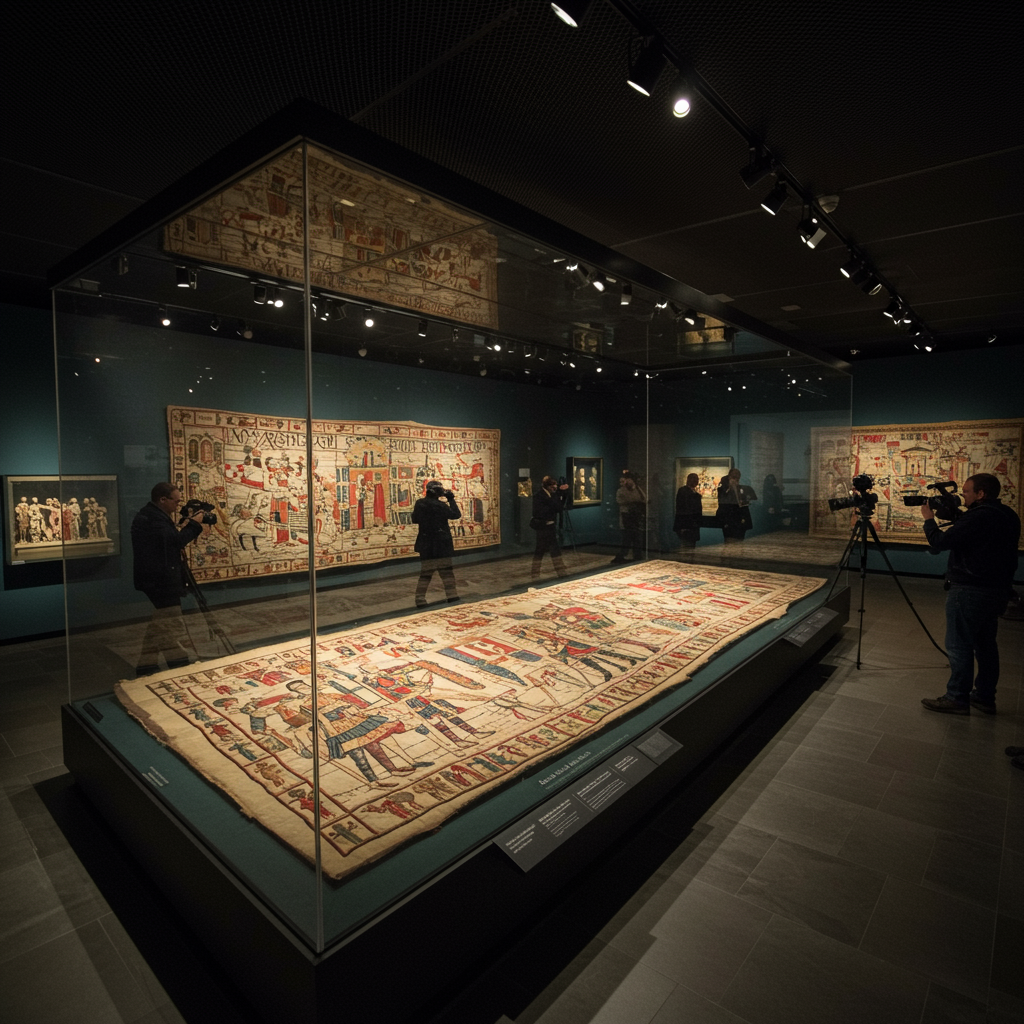A monumental historical event is unfolding: the renowned Bayeux tapestry, a masterpiece of medieval artistry and historical documentation, is confirmed to return to the United Kingdom for the first time in nearly a millennium. This significant loan from France marks a pivotal moment for cultural exchange between the two nations, bringing the extraordinary textile depicting the 1066 Norman Conquest to british soil.
This historic move follows a landmark agreement between the French and British governments. The Department for Culture, Media and Sport (DCMS) has officially confirmed the loan, facilitating the temporary relocation of the iconic embroidery from its permanent home in Normandy to London.
A Medieval Saga Returns Home
Measuring an impressive 70 meters (approximately 230 feet) in length, the Bayeux Tapestry is far more than just an artwork; it is a visual narrative of one of the most transformative periods in English history. Created in the 11th century, widely believed to be in England, potentially by skilled embroiderers in Canterbury, it chronicles the events leading up to the Battle of Hastings and the subsequent victory of William the Conqueror over King Harold Godwinson. The tapestry’s detailed scenes offer unparalleled insights into medieval life, warfare, and customs in both Normandy and England.
With 58 intricate scenes, the tapestry vividly portrays key figures like Harold and William, depicting the political maneuvers, military preparations, and the brutal climax of the Battle of Hastings where Anglo-Saxon dominance gave way to Norman rule. Although the final section is famously missing, the surviving panels end with the Anglo-Saxons in retreat, solidifying the visual record of a decisive moment in history. Its exceptional length, vibrant colours, and detailed workmanship have ensured its status as a uniquely important cultural artifact that has captivated audiences for centuries.
London Exhibition Details Revealed
The Bayeux Tapestry is scheduled for public display at the British Museum in London. This highly anticipated exhibition will be housed in the museum’s Sainsbury Exhibitions Gallery. Visitors can expect to see the tapestry from September 2026 through July 2027.
The timing of this historic loan coincides strategically with significant renovations planned at the Bayeux Museum in Normandy, its usual home. This temporary closure, set to begin in September 2025 for a two-year redevelopment project, makes the loan feasible while ensuring the tapestry remains accessible to the public, albeit in a different location. Furthermore, the exhibition timeframe in 2027 aligns with the 1000th anniversary of the birth of William the Conqueror, adding another layer of historical significance to the display.
A Reciprocal Cultural Exchange
The agreement enabling the Bayeux Tapestry’s journey to the UK is part of a reciprocal cultural exchange. In return for hosting this French national treasure, the British Museum will lend several significant items from its own globally important collection to museums in Normandy.
These treasures include precious artefacts unearthed from the Anglo-Saxon royal burial site at Sutton Hoo. Discovered in 1939, the Sutton Hoo finds provide invaluable context about life and power in England just centuries before the Norman Conquest, offering a poignant counterpoint to the tapestry’s narrative. Additionally, the famous 12th-century Lewis chess pieces, intricate walrus ivory carvings found in Scotland, will also travel to France as part of this cultural exchange. This two-way loan highlights a commitment to sharing heritage and fostering international partnership.
Orchestrating a Landmark Agreement
The concept of bringing the Bayeux Tapestry to the UK has been discussed for years. French President Emmanuel Macron first publicly suggested the possibility of a loan in 2018 during discussions with then-Prime Minister Theresa May. At that time, the idea was framed, in part, as a symbol of enduring connections between the UK and France amid the context of Brexit.
However, previous attempts faced significant hurdles. A conservation report in 2021 concluded that the tapestry was too fragile to travel safely due to various forms of deterioration from historical handling and display methods. Fortunately, a major conservation project on the tapestry commenced in January 2025. This crucial work, likely addressing the identified fragilities, seems to have paved the way for the current, formalized agreement.
The deal was officially confirmed during a state visit, with key figures like UK Prime Minister Keir Starmer and French President Emmanuel Macron expected to make the formal announcement. This high-level involvement underscores the diplomatic as well as cultural importance of the loan, reinforcing the view of the UK and France as strategic partners and friends linked by history and trust.
Anticipating a Blockbuster Exhibition
Museum officials and cultural leaders are expressing immense excitement about the upcoming exhibition. George Osborne, Chair of Trustees at the British Museum, described the planned show as potentially “the blockbuster show of our generation,” drawing comparisons to past hugely successful exhibitions like those featuring Tutankhamun or the Terracotta Warriors. With the British Museum welcoming millions of visitors annually (over 6.5 million in 2024), the venue is exceptionally well-positioned to ensure the widest possible audience can experience this unique artifact firsthand.
Culture Secretary Lisa Nandy welcomed the loan, calling the Bayeux Tapestry “one of the most iconic pieces of art ever produced in the UK.” She views the loan as a powerful “symbol of our shared history with our friends in France, a relationship built over centuries and one that continues to endure.” Nicholas Cullinan, Director of the British Museum, echoed this sentiment, highlighting the tapestry as “one of the most important and unique cultural artefacts in the world” that illustrates the deep ties between Britain and France. He noted the “extraordinary opportunity” to display the tapestry in the UK for the first time since its creation.
The educational value of the exhibition is also a key focus. The story of King Harold, William the Conqueror, and the year 1066 is a fundamental part of the curriculum for British schoolchildren. The loan offers a unique chance for thousands of students and the general public to see this foundational historical document with their own eyes, providing a tangible connection to the past that words in textbooks cannot replicate.
Broader Implications and Cultural Context
The Bayeux Tapestry loan is part of a larger cultural season planned for 2027 between the UK and France. This season is set to celebrate not only the millennium of William the Conqueror’s birth but also includes the Grand Départ of the 2027 Tour de France taking place in the UK. This integrated approach links a pivotal historical event to contemporary Anglo-French relations and significant cultural and sporting ties. The Normandy Region is also inviting UK museums to participate in an international programme to mark the millennium, further deepening the cultural exchange.
Interestingly, some observers of the British Museum have noted that this landmark reciprocal loan arrangement could potentially serve as a “template” for ongoing discussions about the future of other significant cultural artifacts, specifically the Parthenon Sculptures. Groups advocating for the return of these sculptures to Greece have proposed similar “win-win” solutions involving reciprocal loans of never-before-seen Greek artifacts to the British Museum in exchange for the marbles. While the focus remains on the Bayeux Tapestry exhibition, the framework of this agreement highlights evolving approaches to international museum loans and cultural heritage.
The Bayeux Tapestry’s narrative style, using small, detailed images to construct a sprawling historical account, has influenced countless artists over the centuries. From traditional history painting to contemporary works, its impact on visual storytelling is undeniable. Even modern artists, such as David Hockney with his “A Year in Normandy” Frieze or Britta Marakatt-Labba’s Historjá tapestry, have drawn inspiration from this remarkable eleventh-century textile. The upcoming exhibition provides a chance to appreciate not just its historical record but its enduring artistic legacy.
Frequently Asked Questions
What is the Bayeux Tapestry and why is its return to the UK significant?
The Bayeux Tapestry is a 70-meter-long embroidered cloth created in the 11th century, likely in England. It visually depicts the events leading up to and including the 1066 Norman Conquest of England and the Battle of Hastings. Its return to the UK is highly significant because it marks the first time this iconic historical artifact, which narrates a foundational event in British history, will be displayed on British soil in almost 1,000 years since its creation.
Where and when will the Bayeux Tapestry be displayed in the UK?
The Bayeux Tapestry will be displayed at the British Museum in London. The exhibition is scheduled to run from September 2026 until July 2027. This timing coincides with renovations at its usual home, the Bayeux Museum in Normandy, France, and also aligns with the 1000th anniversary of William the Conqueror’s birth in 2027.
How does this loan relate to other cultural exchanges or historical events?
This loan is part of a reciprocal cultural exchange agreement where the British Museum will lend significant UK treasures, such as artifacts from Sutton Hoo and the Lewis chess pieces, to museums in Normandy. It is also integrated into a broader UK-France cultural season in 2027 celebrating William the Conqueror’s millennium and featuring the Tour de France Grand Départ in the UK. Some observers also see it as a potential model for future international loans, including discussions about the Parthenon Sculptures.
Conclusion
The impending arrival of the Bayeux Tapestry in the UK is more than just an exhibition; it’s a homecoming of sorts for a piece of art widely believed to have been created on British shores. This historic loan, a testament to enduring Anglo-French relations and diplomatic effort, offers an extraordinary opportunity for a new generation to connect directly with the dramatic events of 1066. Set to be a major cultural highlight of 2026-2027, the British Museum’s display promises to be a truly once-in-a-generation experience, bringing the vivid story of the Norman Conquest to life for thousands of visitors, especially British schoolchildren, for the first time in nearly a thousand years. The reciprocal exchange of treasures further underscores the power of cultural partnership in celebrating shared heritage.




